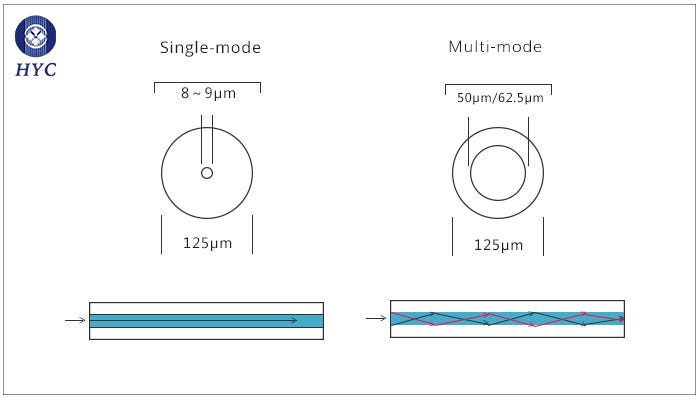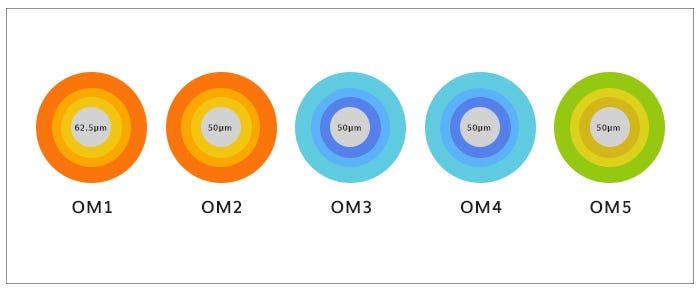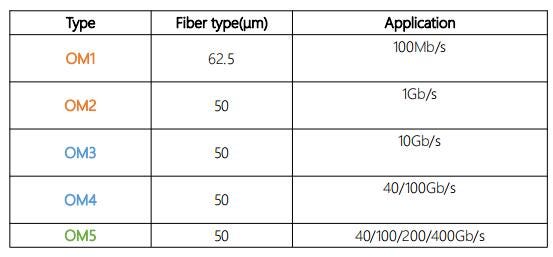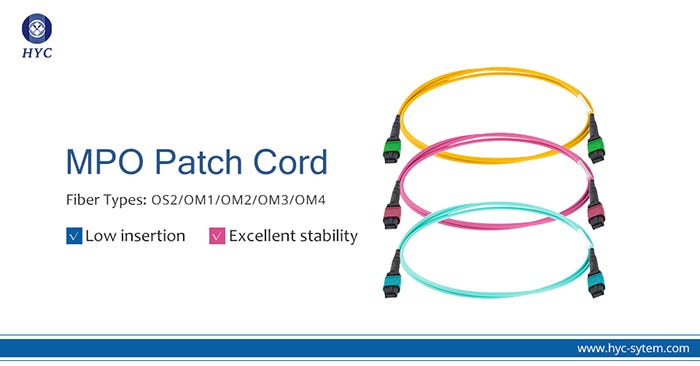- Posts: 36
- Thank you received: 2
×
Questions regarding all aspects of Fiber Optics manufacturing and production go here.
What are the advantages of OM5 fiber patch cord?
- Mrs Bella Tse
- Topic Author
- Offline
- Junior Boarder
-

Less
More
5 years 6 months ago #3039
by Mrs Bella Tse
What are the advantages of OM5 fiber patch cord? was created by Mrs Bella Tse
“OM” is abbreviated for optical multimode, and it is specified by the ISO/IEC 11801 international standard. Currently, TIA and IEC defined fiber patch cord standards are OM1, OM2, OM3, OM4, and OM5.
What are single-mode and multi-mode? There are two different kinds of optical fiber cables, single-mode(OS) and multimode(OM). Single-Mode Fiber is an optical fiber that allows only one mode of transmission. The core diameter is about 8 to 9μm and the outer diameter is about 125μm. Multimode Optical Fiber allows different modes of light to be transmitted over a single fiber with a core diameter of 50μm and 62.5μm. Generally, single-mode fiber supports longer transmission distances than multi-mode fiber. In 100Mbps Ethernet to 1G Gigabit, single-mode fiber can support transmission distances over 5000m. Multimode fiber is only suitable for a medium and short distance and small capacity fiber optic communication systems. Multi-mode is cost-effective for installations where the lengths don't exceed a few hundred meters.
What is the difference between OM1, OM2, OM3, OM4, OM5?
In general, OM1 is conventional 62.5/125μm; OM2 is conventional 50/125μm; OM3 is 850nm laser-optimized 50μm core multimode fiber, and in 10Gb/s Ethernet with 850nm VCSEL, the fiber transmission distance can reach 300m; OM4 is an upgraded version of OM3. OM4 multimode fiber optimizes the differential mode delay (DMD) generated by OM3 multimode fiber during high-speed transmission. Therefore, the transmission distance is greatly improved, and the fiber transmission distance can reach 550m; OM5 is a new standard for fiber patch cords defined by TIA and IEC with a fiber diameter of 50/125μm. Compared to OM3 and OM4 fiber patch cords, OM5 fiber patch cords can be used for higher bandwidth applications. The bandwidth and maximum distance are different for different levels of transmission.
What is OM5 fiber?
OM5, previously known as wideband multimode fiber or WBMMF. Known as Wideband Multimode Fiber Patch Cable (WBMMF), OM5 fiber is a laser-optimized multimode fiber (MMF) designed to specify bandwidth characteristics for wavelength division multiplexing (WDM). The new fiber classification method is designed to support a variety of "short" wavelengths between 850 nm and 950 nm, which are suitable for high bandwidth applications after polymerization. The OM3 and OM4 are designed primarily to support a single wavelength of 850 nm.
The difference from OM3, OM4?
Jacket Color
OM1 and OM2 cable typically come with an orange jacket. OM3 and OM4 have a suggested jacket color of aqua. The color of the OM5 fiber jacket was chosen as lime green.
Different application scopes
OM1 and OM2 have been widely deployed in buildings for many years, supporting Ethernet transmissions up to 1GB. OM3 and OM4 cables are commonly used in data center cabling environments, supporting 10G or even 40/100G Fast Ethernet. Designed for 40Gb/s and 100Gb/s transmission, the OM5 reduces the number of fibers that can be transmitted at high speeds.
OM5 multimode fiber features
Fewer fibers support higher bandwidth applications
The OM5 fiber patch cord has an operating wavelength of 850/1300 nm and can support at least 4 wavelengths. The typical operating wavelengths of OM3 and OM4 are 850 nm and 1300 nm. That is to say, the traditional OM1, OM2, OM3, and OM4 multimode fibers have only one channel, while the OM5 has four channels, and the transmission capacity is increased by four times. Combining short-wavelength division multiplexing (SWDM) and parallel transmission technology, OM5 only requires 8-core wideband multimode fiber (WBMMF), which can support 200/400G Ethernet applications, greatly reducing the number of fiber cores. The cabling costs of the network are reduced.
Longer transmission distance
The transmission distance of OM5 fiber is longer than that of OM3 and OM4. The OM4 fiber is designed to support a length of at least 100 meters with a 100G-SWDM4 transceiver. But OM5 fiber can support up to 150 meters in length with the same transceiver.
Lower fiber loss
The attenuation of the OM5 broadband multimode cable has been reduced from 3.5dB/km for the previous OM3, OM4 cable to 3.0dB/km, and the bandwidth requirement of 953 nm wavelength has been increased.
OM5 has the same fiber size as OM3 and OM4, which means it is fully compatible with OM3 and OM4. The existing cabling network does not need to be changed to apply to OM5. OM5 fiber is more scalable and flexible, which can support higher-speed network transmission with fewer multimode fiber cores. The cost and power consumption are much lower than single-mode fiber. Therefore, it will be widely used in 100G/400G/1T ultra-large data centers in the future.
HYC offers various kinds of fiber optic patch cords, including OS, OM1, OM2, OM3, OM4 OM5 fibers. HYC also provides fiber optic cables adapted to customers' specific requirements. www.hyc-system.com
What are single-mode and multi-mode? There are two different kinds of optical fiber cables, single-mode(OS) and multimode(OM). Single-Mode Fiber is an optical fiber that allows only one mode of transmission. The core diameter is about 8 to 9μm and the outer diameter is about 125μm. Multimode Optical Fiber allows different modes of light to be transmitted over a single fiber with a core diameter of 50μm and 62.5μm. Generally, single-mode fiber supports longer transmission distances than multi-mode fiber. In 100Mbps Ethernet to 1G Gigabit, single-mode fiber can support transmission distances over 5000m. Multimode fiber is only suitable for a medium and short distance and small capacity fiber optic communication systems. Multi-mode is cost-effective for installations where the lengths don't exceed a few hundred meters.
What is the difference between OM1, OM2, OM3, OM4, OM5?
In general, OM1 is conventional 62.5/125μm; OM2 is conventional 50/125μm; OM3 is 850nm laser-optimized 50μm core multimode fiber, and in 10Gb/s Ethernet with 850nm VCSEL, the fiber transmission distance can reach 300m; OM4 is an upgraded version of OM3. OM4 multimode fiber optimizes the differential mode delay (DMD) generated by OM3 multimode fiber during high-speed transmission. Therefore, the transmission distance is greatly improved, and the fiber transmission distance can reach 550m; OM5 is a new standard for fiber patch cords defined by TIA and IEC with a fiber diameter of 50/125μm. Compared to OM3 and OM4 fiber patch cords, OM5 fiber patch cords can be used for higher bandwidth applications. The bandwidth and maximum distance are different for different levels of transmission.
What is OM5 fiber?
OM5, previously known as wideband multimode fiber or WBMMF. Known as Wideband Multimode Fiber Patch Cable (WBMMF), OM5 fiber is a laser-optimized multimode fiber (MMF) designed to specify bandwidth characteristics for wavelength division multiplexing (WDM). The new fiber classification method is designed to support a variety of "short" wavelengths between 850 nm and 950 nm, which are suitable for high bandwidth applications after polymerization. The OM3 and OM4 are designed primarily to support a single wavelength of 850 nm.
The difference from OM3, OM4?
Jacket Color
OM1 and OM2 cable typically come with an orange jacket. OM3 and OM4 have a suggested jacket color of aqua. The color of the OM5 fiber jacket was chosen as lime green.
Different application scopes
OM1 and OM2 have been widely deployed in buildings for many years, supporting Ethernet transmissions up to 1GB. OM3 and OM4 cables are commonly used in data center cabling environments, supporting 10G or even 40/100G Fast Ethernet. Designed for 40Gb/s and 100Gb/s transmission, the OM5 reduces the number of fibers that can be transmitted at high speeds.
OM5 multimode fiber features
Fewer fibers support higher bandwidth applications
The OM5 fiber patch cord has an operating wavelength of 850/1300 nm and can support at least 4 wavelengths. The typical operating wavelengths of OM3 and OM4 are 850 nm and 1300 nm. That is to say, the traditional OM1, OM2, OM3, and OM4 multimode fibers have only one channel, while the OM5 has four channels, and the transmission capacity is increased by four times. Combining short-wavelength division multiplexing (SWDM) and parallel transmission technology, OM5 only requires 8-core wideband multimode fiber (WBMMF), which can support 200/400G Ethernet applications, greatly reducing the number of fiber cores. The cabling costs of the network are reduced.
Longer transmission distance
The transmission distance of OM5 fiber is longer than that of OM3 and OM4. The OM4 fiber is designed to support a length of at least 100 meters with a 100G-SWDM4 transceiver. But OM5 fiber can support up to 150 meters in length with the same transceiver.
Lower fiber loss
The attenuation of the OM5 broadband multimode cable has been reduced from 3.5dB/km for the previous OM3, OM4 cable to 3.0dB/km, and the bandwidth requirement of 953 nm wavelength has been increased.
OM5 has the same fiber size as OM3 and OM4, which means it is fully compatible with OM3 and OM4. The existing cabling network does not need to be changed to apply to OM5. OM5 fiber is more scalable and flexible, which can support higher-speed network transmission with fewer multimode fiber cores. The cost and power consumption are much lower than single-mode fiber. Therefore, it will be widely used in 100G/400G/1T ultra-large data centers in the future.
HYC offers various kinds of fiber optic patch cords, including OS, OM1, OM2, OM3, OM4 OM5 fibers. HYC also provides fiber optic cables adapted to customers' specific requirements. www.hyc-system.com
Please Log in to join the conversation.
Moderators: Erik A Macs, Peter J Stewart-Hay
Time to create page: 0.061 seconds





 How to resolve AdBlock issue?
How to resolve AdBlock issue? 



